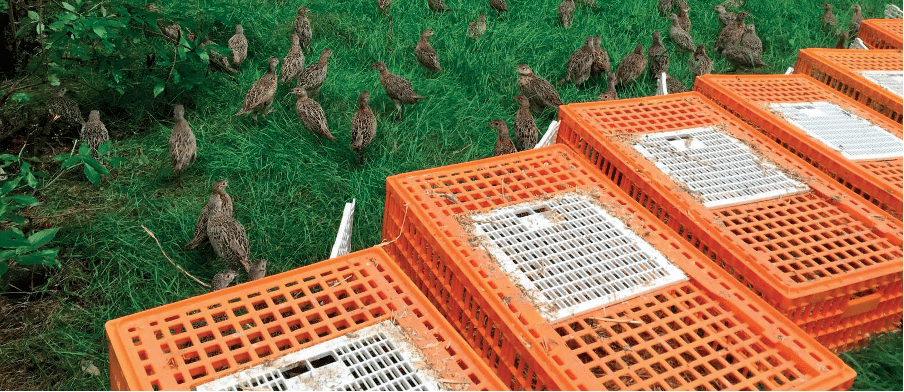News
From the Game Farm
Would you like to speak to our readers? We offer sponsored articles and advertising to put you in front of our audience. Find out more.
Efforts to reduce antibiotic use in gamebirds are making progress, but Dominic Boulton urges further reduction and awareness.
Since the publication of the O’Neill report in 2016, antibiotics (ABs) have been a subject of much focus and debate. The report predicted that if the then current trend continued, antimicrobial resistance (AMR) would be responsible for more human deaths than cancer by 2050. This startling statistic really drives home how important this issue is for human health, but you might not realise that there is a considerable overlap with the world of game shooting.
AMR results from the use of ABs and although certain practices can be more damaging in this respect, the bottom line is that the more ABs we use the quicker AMR develops. The hospital superbug MRSA is an example of how AMR manifests itself in human health, but ABs are also used in the treatment of animals and rearing gamebirds is no exception. Regardless of whether the patient is human, bovine, canine or a galliform — the order of birds that includes most game — the use of ABs will contribute to the increasing AMR problem.
Consequently all livestock sectors, along with human medicine and small animal (pet) veterinary practices, have been under pressure to reduce our reliance on these important drugs and minimise the problems that AMR will inevitably cause. When the Veterinary Medicines Directorate called on livestock sectors to help tackle this important issue, the GFA stepped forward to represent the game sector and joined the Responsible Use of Medicines in Animals Targets Taskforce (TTF).
Since then great progress has been made. Our use of ABs last year was about half that of the baseline year of 2016, despite more birds being reared and released. However, much of this progress was made in the first few years and as the law of diminishing returns predicts, further reductions have proved harder to secure. We achieved our TTF1 target a year ahead of schedule in 2019, but our TTF2 target for 2024 looks unrealistic based on the past couple of years — the data isn’t available yet.
Many of the ABs used in the game sector are used to treat hexamita in recently released birds, and reducing stocking density and improving pen quality are crucial factors in driving further sustainable reductions in AB use. In collaboration with leading gamebird vets, the GFA produced the Pen Scoring Guide to help keepers better understand how release pens can be improved and to consider this aspect when planning new ones. You can access the guide from the GFA website by scanning the QR code below — why not see how the pens on your shoot measure up?
The GFA has also supported research into intestinal parasites of gamebirds — this includes hexamita — and how to treat them. This has produced some interesting findings but there is still a lot more work required before this translates into reducing the incidence of gut parasites or finding alternative ways to treat them, and research is very expensive.
Stressful transition
For the moment, prevention is better than cure and all shoots, big and small, should be working closely with their vet and poult supplier to manage the stressful transition from the rearing field to the release pen and beyond. There are also other benefits to the shoot. ABs and prescriptions are expensive, and birds always seem to grow more quickly if disease challenges can be avoided around the time of release.
Managing AB use should never compromise welfare, however, and the overriding maxim is “as much as required but no more than necessary”. Once unnecessary use has been minimised, the key to making sustainable reductions is to improve systems and welfare so that less medical intervention is required.
Related articles
News
PETA attacks royal couple for breeding cocker pups
The Prince and Princess of Wales have faced criticism from animal rights group PETA after they had a litter of puppies
By Time Well Spent
News
Farmers launch legal review against Reeves’s farm tax
Chancellor Rachel Reeves faces a judicial review over inheritance tax reforms that could force family farms out of business
By Time Well Spent
Manage Consent
To provide the best experiences, we use technologies like cookies to store and/or access device information. Consenting to these technologies will allow us to process data such as browsing behavior or unique IDs on this site. Not consenting or withdrawing consent, may adversely affect certain features and functions.
Functional Always active
The technical storage or access is strictly necessary for the legitimate purpose of enabling the use of a specific service explicitly requested by the subscriber or user, or for the sole purpose of carrying out the transmission of a communication over an electronic communications network.
Preferences
The technical storage or access is necessary for the legitimate purpose of storing preferences that are not requested by the subscriber or user.
Statistics
The technical storage or access that is used exclusively for statistical purposes.
The technical storage or access that is used exclusively for anonymous statistical purposes. Without a subpoena, voluntary compliance on the part of your Internet Service Provider, or additional records from a third party, information stored or retrieved for this purpose alone cannot usually be used to identify you.
Marketing
The technical storage or access is required to create user profiles to send advertising, or to track the user on a website or across several websites for similar marketing purposes.





